Point of Contact: Archaeology at Culloden
Point of Contact: Archaeology at Culloden
Culloden may have been the last battle of the Jacobite risings, but it was also the first battlefield in Scotland to be subject to archaeological investigation. The first phase of this long-term project took place in 2001 as part of the BBC television series Two Men in a Trench but has since continued under the auspices of the National Trust for Scotland as part of the Culloden Battlefield Memorial Project. The investigation carried out by the Centre for Battlefield Archaeology has included topographic, geophysical and metal detector surveys along with archaeological excavation.
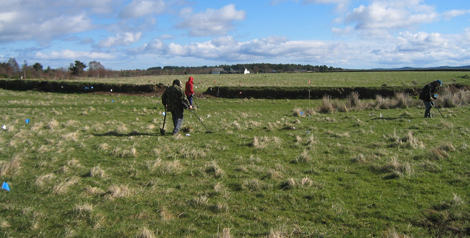
Perhaps the most obviously rewarding element of this work has been the metal detector survey, which has revealed a rich assemblage of metal objects related to the battle, including musket balls, cannon shot, mortar shell fragments, pieces broken from muskets, buttons, buckles, personal possessions, such as a king’s shilling and a pewter cross and even a bayonet. But interesting as these objects are it is only when they are considered in relation to where they were found (their archaeological context) that they really begin to tell us something meaningful about the battle. The debris left behind after the battle, be it in the form of a fired musket ball falling to the ground after missing its target, or a coin dropped by a charging Highlander, are pieces of evidence which can be subject to a battery of forensic tests.
The archaeological project has provided a number of sometimes surprising insights into the battle. For instance, the distribution of the finds and the location of structures such as field walls, which appeared on contemporary maps of the battle, demonstrate that the battle took place over a wider expanse of ground than was originally appreciated when the battlefield was first displayed to the public. The location of the brutal hand-to-hand fighting between the Jacobite right and centre and the government regiments of Barrel and Monro, took place much further to the south than was previously fought. For us today this was fortunate, as the area known as the Field of the English, from which many of the finds dropped in this fight were recovered, has been left relatively undisturbed since the battle, whereas the area further north was planted with trees in the 19th century.
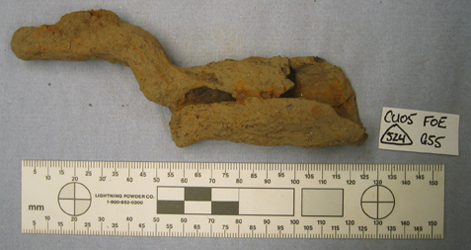 The location of this vicious contact, where Jacobite broadswords met government bayonets, has left a pattern of dropped objects which can be read like a signature etched into the landscape. For instance, this is the only place on the battlefield where a large number of pistol balls were found, each of them having been fired at the close range at which these weapons were effective. There are pieces of broken musket either shot away by a musket ball fired at close range or smashed off by the stroke of a broadsword. Buckles and buttons have also been torn off in the struggle. It is here that musket balls were found in their greatest numbers, some of them mirroring the lines of men who fired them into the seething mass of the enemy. To an extent we can tell which were fired by the Jacobites and which by the government troops as the Jacobites used French muskets with a slightly smaller calibre than the Brown Bess. This is not to say however that every Brown Bess bullet was fired by a government redcoat as large numbers of these weapons were captured by the Jacobites after earlier victories at the battles of Prestonpans and Falkirk. Even without considering this last factor however it is clear that the Jacobites were using their muskets in greater numbers than has usually been considered – with the traditional picture having them throw away their muskets after firing one shot part way through the charge and then going in with the sword. Some of these bullets have been dropped without being fired, some missed their targets but others have been distorted through their contact with a human body and it is a sobering experience to handle and study one of these and think that they may well have killed another human being.
The location of this vicious contact, where Jacobite broadswords met government bayonets, has left a pattern of dropped objects which can be read like a signature etched into the landscape. For instance, this is the only place on the battlefield where a large number of pistol balls were found, each of them having been fired at the close range at which these weapons were effective. There are pieces of broken musket either shot away by a musket ball fired at close range or smashed off by the stroke of a broadsword. Buckles and buttons have also been torn off in the struggle. It is here that musket balls were found in their greatest numbers, some of them mirroring the lines of men who fired them into the seething mass of the enemy. To an extent we can tell which were fired by the Jacobites and which by the government troops as the Jacobites used French muskets with a slightly smaller calibre than the Brown Bess. This is not to say however that every Brown Bess bullet was fired by a government redcoat as large numbers of these weapons were captured by the Jacobites after earlier victories at the battles of Prestonpans and Falkirk. Even without considering this last factor however it is clear that the Jacobites were using their muskets in greater numbers than has usually been considered – with the traditional picture having them throw away their muskets after firing one shot part way through the charge and then going in with the sword. Some of these bullets have been dropped without being fired, some missed their targets but others have been distorted through their contact with a human body and it is a sobering experience to handle and study one of these and think that they may well have killed another human being.
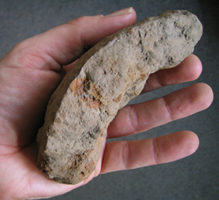
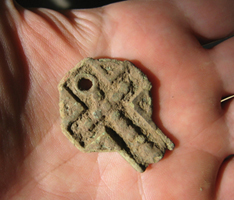 A new insight into how seriously the government army regarded the Jacobite charge has also been obtained through the metal detector survey. Very close to where the hand-to-hand fighting took place were found several heavy iron fragments from spherical mortar bombs which had been fired into the on-coming Jacobites in an attempt to stop the charge. These were found so close to the front of the government line that there must have been some risk of these unpredictable weapons, which fragment when the powder inside the hollow balls ignites, killing men on both sides, or incurring ‘friendly fire’ as we call it today. When these shell fragments are considered alongside the hail of cannon fire and musketry into which the Jacobites charged it is a wonder that they managed to reach the government line at all, and this achievement is certainly a testimony to the bravery of the Highlanders.
A new insight into how seriously the government army regarded the Jacobite charge has also been obtained through the metal detector survey. Very close to where the hand-to-hand fighting took place were found several heavy iron fragments from spherical mortar bombs which had been fired into the on-coming Jacobites in an attempt to stop the charge. These were found so close to the front of the government line that there must have been some risk of these unpredictable weapons, which fragment when the powder inside the hollow balls ignites, killing men on both sides, or incurring ‘friendly fire’ as we call it today. When these shell fragments are considered alongside the hail of cannon fire and musketry into which the Jacobites charged it is a wonder that they managed to reach the government line at all, and this achievement is certainly a testimony to the bravery of the Highlanders.
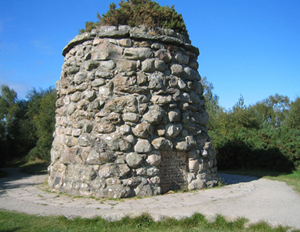 The mortar bombs did not stop the charge, but heavy musketry and tight discipline among the government ranks did. Despite the onslaught the line held and a killer blow was delivered to the Jacobites when regiments in the second line moved round to deliver musket fire into their flank. When the fighting ended more than one thousand Jacobites lay dead. Today the mass graves of these fallen Jacobites are clearly marked, but those of the sixty or so government soldiers killed in the fighting are not. One of the aims of the project was to locate these unmarked graves, and we believe that thanks to geophysics and a silver coin we are closer to doing that.
The mortar bombs did not stop the charge, but heavy musketry and tight discipline among the government ranks did. Despite the onslaught the line held and a killer blow was delivered to the Jacobites when regiments in the second line moved round to deliver musket fire into their flank. When the fighting ended more than one thousand Jacobites lay dead. Today the mass graves of these fallen Jacobites are clearly marked, but those of the sixty or so government soldiers killed in the fighting are not. One of the aims of the project was to locate these unmarked graves, and we believe that thanks to geophysics and a silver coin we are closer to doing that.
The coin dates to 1752 and is a silver Thaler from the Duchy of Mecklenburg-Schwerin, which was one of the German Baltic states. It is possible that this unusual coin was dropped by a soldier who had served on the continent but some time later was in the Highlands, perhaps stationed at nearby Fort George. While there he may have taken time out to visit the graves of fallen comrades when they were still marked in some way – perhaps by mounds like the Jacobite graves today. This coin may in effect be the ‘X’ that marks the spot, which according to the geophysics looks to be a large straight edged burial pit sitting directly below where the coin was found.
For more details about visiting the Culloden Visitor Centre follow this link to the National Trust Website.

